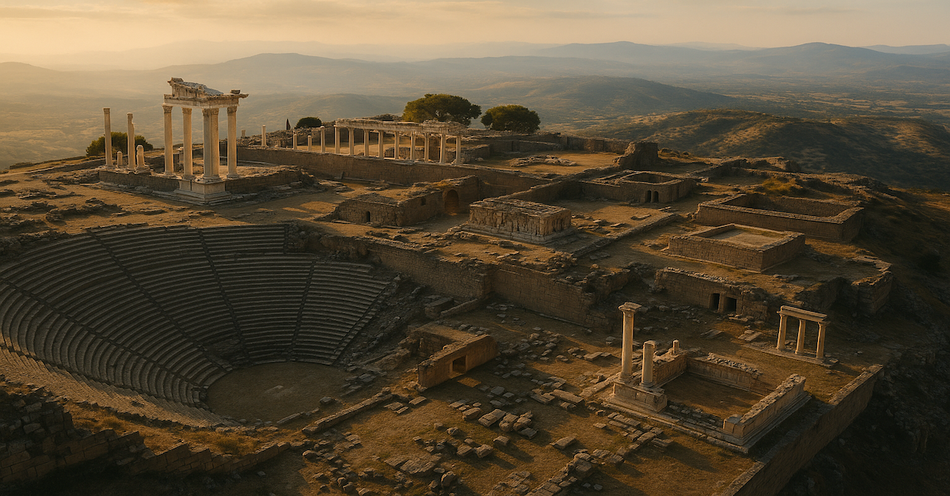In Revelation 2:12-17, Jesus sent a letter to the church in Pergamum (also known as Pergamon or its modern Greek form Pergamos), saying that they lived where Satan’s throne is. Pergamum was an idolatrous city with many temples to the gods of the Greeks and the imperial cult of Rome.
The church of Pergamum was the third of the Seven Churches in Asia Minor to which Jesus had the Apostle John send letters. Each letter began with a description of Christ, the church’s circumstances, a rebuke, and a promise. The letter to the church in Pergamum described a church struggling to be faithful to Christ in a world seeking to pull it away. Jesus called the church in Pergamum to repent and turn back to Him, or else He will come with judgment.
What Was the Church at Pergamum Known For?
The church of Pergamum is one of the Seven Churches mentioned in Revelation (Revelation 2:12-17). Jesus accused the church of being influenced by the local idolaters and of not remaining faithful to him.
Pergamum was an influential city during the Hellenistic and Roman periods. During the Hellenistic Period, it was the capital of the Kingdom of Pergamum. When Rome rose to power, Roman leaders made Pergamos the seat of the regional assembly.
Pergamum, a Roman city, featured a major pagan worship center, with prominent temples dedicated to the Greek gods Zeus, Athena, Isis/Serapis, and Apollo. During the time of Revelation, Caesar Augustus claimed to be divine and demanded worship from the people under Roman rule, including the Jews and Christians in Jerusalem.
Between the worship of the Greek gods and the Roman rulers, the Christians in Pergamum were under intense persecution. Revelation 2:13 mentions the martyrdom of Antipas. According to Christian tradition, Antipas was the first bishop of Pergamum and had been ordained by John the Apostle. In 92 AD, an angry mob of worshippers of Serapis grabbed Antipas and burned him alive in front of the Temple of Serapis.
What Does “Satan’s Throne” Mean?
The term “Satan’s Throne” that Jesus used for Pergamum (Pergamos) was very applicable because of the city’s bent to idolatry. Whether the term was used to refer to the city’s immorality or to a specific example, the point of their unfaithfulness is still valid. Some specific examples are:
- The Imperial Cult: Augustus Caesar established the cult of emperor worship at the turn of the first century BC, and a lavish temple was built in honor of Rome and Augustus in Pergamum.
- The Pergamon Altar: The Pergamon Altar, the Altar of Zeus, was a large, throne-shaped altar built in the first half of the 2nd century BC on the terraces of the acropolis. Listed as one of the Seven Wonders of the Ancient World, the structure was 117 ft. wide and 109 ft. deep. In 1878, German engineer Carl Humann began excavations on the Acropolis. He dismantled the relief panels and transferred them to Berlin, where they sat in storage for years. In 1930, the altar was displayed in East Berlin’s Pergamum Museum during the rise of Hitler. It still resides there today.
- The Temple of Aesculapius: Pergamum had a temple dedicated to Aesculapius, the god of healing. The sick and disabled visited the temple seeking healing through dreams and rituals with snakes.
Where Was Pergamum Located?
The site of the ruins of Pergamum is near the modern-day town of Bergama, in the Izmir province of Turkey. Its location in Asia Minor, near the Aegean Sea, made it a strategic location for commerce and military purposes. Pergamum is the northernmost of the Seven Churches in Revelation. UNESCO designated the site as a World Heritage site, and it is currently a popular tourist destination.
The city of Pergamum was abandoned in the 14th century AD when the Ottoman Empire came to power. Excavations of the ruins began in the 1870s by the German Carl Humann. Although many artifacts were relocated to Berlin, the ruins still include the foundations of the city’s temples, theaters, and its famous library.
Jesus’ Warning and Promise to the Pergamum Church
The letter to the church at Pergamum in Revelation 2:12-17 contains a warning and a promise. The warning was to remind Jesus' followers not to worship or follow other gods. Then, He promised to “he who has an ear,” to provide for their needs (manna) and to have a personal relationship with them (white stone). We will look at each of these warnings and promises more below.
Since the church in Pergamum lived in a city with such a pagan influence, Christ acknowledged their faithfulness to Him. However, He also gave examples of how the church had slipped in their stand on biblical teachings.
1. First Warning: The Teachings of Balaam
The story of Balaam and Balak can be found in Numbers 22-25. King Balak of Moab hired the prophet Balaam to curse the Israelites as they traveled through the wilderness. After Balaam refused several times to curse the multitude, he advised the Moabites to entice the Israelites to join in their sacrificing and worshipping to their idols. God responded by sending a plague, and 24,000 died (Numbers 25:1-9).
2. Second Warning: The Teachings of the Nicolaitans
The Nicolaitans, also mentioned in Acts 6 and Revelation 2:6 in the letter to the church in Ephesus, were a heretical Christian sect. Traditionally, the Nicolaitans were followers of Nicolas the Deacon in Acts 6, who encouraged the early believers to accept pagan practices and disregard the teachings of the apostles.
In contrast to Jesus’ warnings to the believers tempted to follow the pagan worshippers, he made two promises to “he who has an ear” and “to him who overcomes" (Revelation 2:17).
1. First Promise: Hidden Manna
When the Israelites were traveling through the wilderness, they cried out to God because there wasn’t enough food. God sent down manna (in Hebrew, manna means “what is it”) to feed the vast multitude. In the text in Revelation, this manna may be seen as a promise from Jesus to provide for His followers’ needs.
2. Second Promise: The White Stone
A white stone had a couple of meanings in the culture of that day. First, in ancient Greece, when a person stood for trial in a courtroom, the members of the jury would signify the defendant was guilty by casting a black stone. In contrast, a white stone showed they had found him or her innocent. In this case, Jesus is saying that he finds the one who remained faithful to be innocent.
Another use of a white stone was as an award to the winner of an athletic competition. The winner would be given a stone inscribed with his name, and it would serve as his ticket to the special awards. This shows Jesus inviting His followers to the eternal banquet He will hold for His followers in Heaven.
What Lessons Can We Learn from the Church in Pergamum?
The pagan culture surrounding the Church in Pergamum was similar to our culture today. By holding true to the teachings of Jesus and the apostles despite temptations to compromise, the church in Pergamum is an example of how we should live holy lives, separate from the world.
1. God Demands Total Obedience.
The first commandment is, “You shall have no other gods before Me.” God is a holy and jealous God. He will allow nothing to take the worship due only to Him.
2. God Sees Us Where We Are.
In all His letters to the Seven Churches, Jesus starts with the status of the church and how they are following Him. We might assume that because God is spirit and holy, that He isn’t aware of what we do or who we are. But that isn’t true. There is an old hymn that has the line, “His eye is on the sparrow, so I know He watches me.” Not only does He see our sins, He also sees our faithfulness.
3. God Accepts True Worship.
Contrary to Pergamum’s many altars to false gods and idolatrous practices, there is only one God worthy of worship who enables us to stand before Him blameless through His Son, Jesus. Even though we have all sinned and are not worthy of entering His presence, He sent His Son, Christ Jesus, to die for our sins so we can believe in Him and have eternal life (John 3:16). All the magnificent temples in Pergamum were built for lifeless idols. Only God is the living, omnipotent, Sovereign Savior who invites us to join Him.
As the letter to Pergamum declares in its closing, “Let him who has an ear, let him hear what the Spirit says.”
Related Resource: Are Christians Safe from Demons?
Steve Dabbs is a retired senior military chaplain with over 35 years of full-time expertise in pastoral care. Throughout his life and ministry, he has encountered demonic activity, and today he's here to answer these questions: "Can a Christian be demonized?" "Are Christians Safe from Demonic Activity?" Steve's answers might surprise you, but they are rooted both in church history and scripture. Want more answers to your biggest questions about God, morality, and contemporary culture? Be sure to follow The Sean McDowell Show on Apple or Spotify so you never miss an episode!

This article is part of our larger End Times Resource Library. Learn more about the rapture, the anti-christ, bible prophecy and the tribulation with articles that explain Biblical truths. You do not need to fear or worry about the future!
The Second Coming of Jesus
Who Are the 144,000 in Revelation?
Who Are Gog and Magog in the Bible?
What Is the Apollyon?
Is the Apocalypse Mentioned in the Bible?
Signs of the End Times and the Rapture



